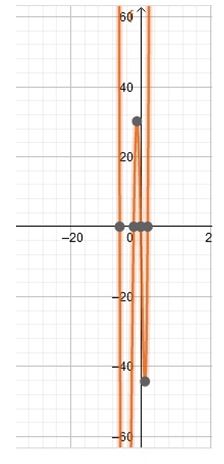
In Problems 107-114, analyze each polynomial function by following Steps 1 through 8 on page 193.
To analyze: The polynomial function.
Answer to Problem 103AYU
.
Explanation of Solution
Given:
Step 1: Determine the end behavior of the graph of the function.
Factor
The polynomial function is of degree 4. The graph of behaves like for large values of .
Step 2: Find and of the graph of the function.
The .
The .
The .
Step 3: Determine the zeros of the function and their multiplicity. Using this information determine whether the graph crosses or touches the at each .
The zeros of .
The zero has odd multiplicity therefore the graph of crosses the .
The zero has odd multiplicity therefore the graph of crosses the .
The zero has odd multiplicity therefore the graph of crosses the .
The zero has odd multiplicity therefore the graph of crosses the .
Step 4: Using the graphing utility to graph the function.

Step 5: Approximate the turning point of the graph.
From the graph of , we see has 3 turning points.
Using the graph maximum turning point .
Using the graph minimum turning point .
Step 6: Redraw the graph.
The graph passes through and .
Step 7: Find the domain and range of the function.
The domain and range is the set of all real numbers.
Step 8: Use the graph to determine where the function is increasing or where it is decreasing.
Based on the graph, is increasing and .
Based on the graph, is decreasing .
Chapter 4 Solutions
Precalculus Enhanced with Graphing Utilities
Additional Math Textbook Solutions
Pre-Algebra Student Edition
Elementary Statistics (13th Edition)
University Calculus: Early Transcendentals (4th Edition)
Calculus: Early Transcendentals (2nd Edition)
Algebra and Trigonometry (6th Edition)
Using and Understanding Mathematics: A Quantitative Reasoning Approach (6th Edition)
- I circled the correct, could you explain using stokearrow_forwardUse Euler's method to numerically integrate dy dx -2x+12x² - 20x +8.5 from x=0 to x=4 with a step size of 0.5. The initial condition at x=0 is y=1. Recall that the exact solution is given by y = -0.5x+4x³- 10x² + 8.5x+1arrow_forwardFind an equation of the line tangent to the graph of f(x) = (5x-9)(x+4) at (2,6).arrow_forward
- Find the point on the graph of the given function at which the slope of the tangent line is the given slope. 2 f(x)=8x²+4x-7; slope of the tangent line = -3arrow_forwardUse the product rule to find the derivative of the following. p(y) (y¹ + y²) (6y¯³-10y¯4)arrow_forwardplease dont use chat gptarrow_forward
- Find this expression in frequency domain in a expression y(t), in time, that is.arrow_forwardplease dont use chat gptarrow_forwardQuestion Given the graph of f(z) below, find the graph of the derivative of f(z). Select the correct answer below: ° 7-6-5-4-3 123 ° ° 2 -7-6-5-4-3- 123 -° 2-4 -°- °- -7-6-5-4-3-2-1 1 5 +arrow_forward
 Calculus: Early TranscendentalsCalculusISBN:9781285741550Author:James StewartPublisher:Cengage Learning
Calculus: Early TranscendentalsCalculusISBN:9781285741550Author:James StewartPublisher:Cengage Learning Thomas' Calculus (14th Edition)CalculusISBN:9780134438986Author:Joel R. Hass, Christopher E. Heil, Maurice D. WeirPublisher:PEARSON
Thomas' Calculus (14th Edition)CalculusISBN:9780134438986Author:Joel R. Hass, Christopher E. Heil, Maurice D. WeirPublisher:PEARSON Calculus: Early Transcendentals (3rd Edition)CalculusISBN:9780134763644Author:William L. Briggs, Lyle Cochran, Bernard Gillett, Eric SchulzPublisher:PEARSON
Calculus: Early Transcendentals (3rd Edition)CalculusISBN:9780134763644Author:William L. Briggs, Lyle Cochran, Bernard Gillett, Eric SchulzPublisher:PEARSON Calculus: Early TranscendentalsCalculusISBN:9781319050740Author:Jon Rogawski, Colin Adams, Robert FranzosaPublisher:W. H. Freeman
Calculus: Early TranscendentalsCalculusISBN:9781319050740Author:Jon Rogawski, Colin Adams, Robert FranzosaPublisher:W. H. Freeman
 Calculus: Early Transcendental FunctionsCalculusISBN:9781337552516Author:Ron Larson, Bruce H. EdwardsPublisher:Cengage Learning
Calculus: Early Transcendental FunctionsCalculusISBN:9781337552516Author:Ron Larson, Bruce H. EdwardsPublisher:Cengage Learning





